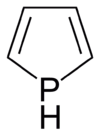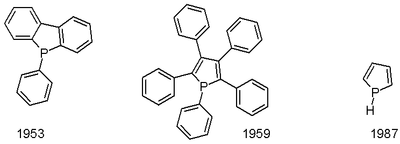Phosphole
| |||
| Names | |||
|---|---|---|---|
| IUPAC name
1H-Phosphole | |||
| Identifiers | |||
| 288-01-7 | |||
| 3D model (Jmol) | Interactive image | ||
| ChemSpider | 144273 | ||
| PubChem | 164575 | ||
| |||
| |||
| Properties | |||
| C4H5P | |||
| Molar mass | 84.06 g·mol−1 | ||
| Related compounds | |||
| Related compounds |
Pyrrole, bismole, arsole, stibole | ||
| Except where otherwise noted, data are given for materials in their standard state (at 25 °C [77 °F], 100 kPa). | |||
| Infobox references | |||
Phosphole is the organic compound with the chemical formula C4H4PH; it is the phosphorus analog of pyrrole. The term phosphole also refers to substituted derivatives of the parent heterocycle. These compounds are of theoretical interest but also serve as ligands for transition metals and as precursors to more complex organophosphorus compounds.
The first phosphole, pentaphenylphosphole, was reported in 1953, and the parent phosphole itself was first described in 1987.[1] The usual route to phospholes is via the McCormack reaction, involving the addition of a 1,3-diene to a phosphonous chloride followed by dehydrohalogenation.[2] Phenylphospholes can be prepared via zirconacyclopentadienes by reaction with PhPCl2.[3]
Unlike the related 5-membered heterocycles pyrrole, thiophene, and furan, the aromaticity of phospholes is diminished, reflecting the reluctance of phosphorus to delocalize its lone pair.[4] For example, phospholes undergo Diels-Alder reactions with electrophilic alkynes.
Reactivity
Phosphole chemistry is hampered by its sensitivity to moisture. 2,5-diphenyl phospholes can be functionalised by deprotonation followed by P-acylation then a 1H, 2H, 3H phospholide equilibrium resulting in a 1:3 shift of the acyl group.[5] Phospholes can also be turned into β-functional phosphabenzenes (phosphinines, or phosphorine) via functionalisation by imidoyl chloride and insertion.[6]
See also
References
- ↑ A Guide to Organophosphorus Chemistry Louis D. Quin 2000 John Wiley & Sons ISBN 0-471-31824-8
- ↑ W. B. McCormack (1973). "3-Methyl-1-Phenylphospholene oxide". Org. Synth.; Coll. Vol., 5, p. 787
- ↑ Paul J. Fagan and William A. Nugent (1998). "1-Phenyl-2,3,4,5-Tetramethylphosphole". Org. Synth.; Coll. Vol., 9, p. 653
- ↑ D. B. Chesnut; L. D. Quin (2007). "The important role of the phosphorus lone pair in phosphole aromaticity". Heteroatom Chemistry. 18: 754. doi:10.1002/hc.20364.
- ↑ Magali Clochard; Joanna Grundy; Bruno Donnadieu & François Mathey (2005). "A straightforward synthesis of 3-acylphospholes.". Organic Letters. 7 (20): 4511–4513. doi:10.1021/ol051816d. PMID 16178571.
- ↑ Grundy, J. & Mathey, F. (2005). "One-Pot Conversion of Phospholide Ions into β-Functional Phosphinines". Angewandte Chemie International Edition. 44: 1082–1084. doi:10.1002/anie.200462020.


